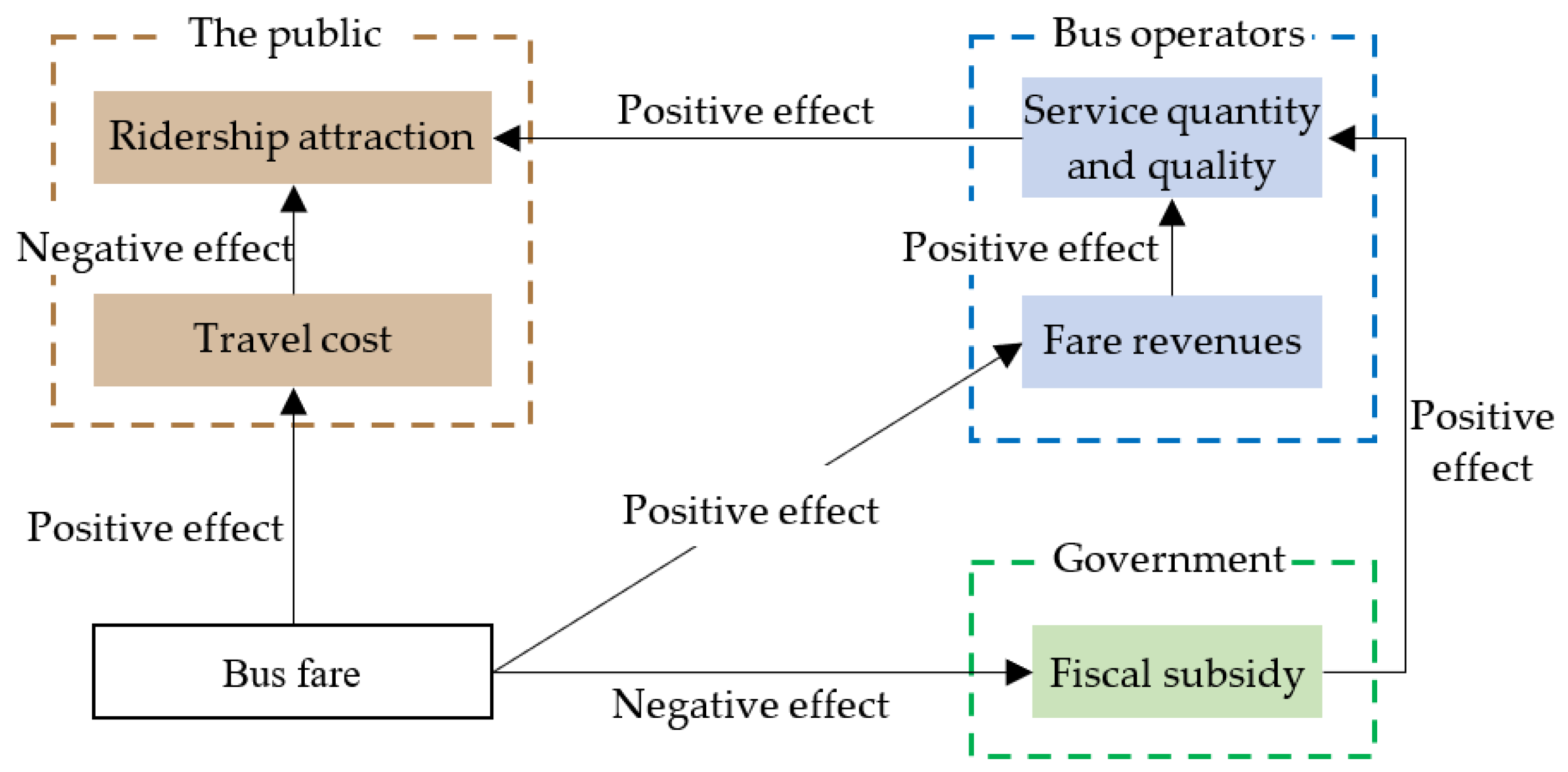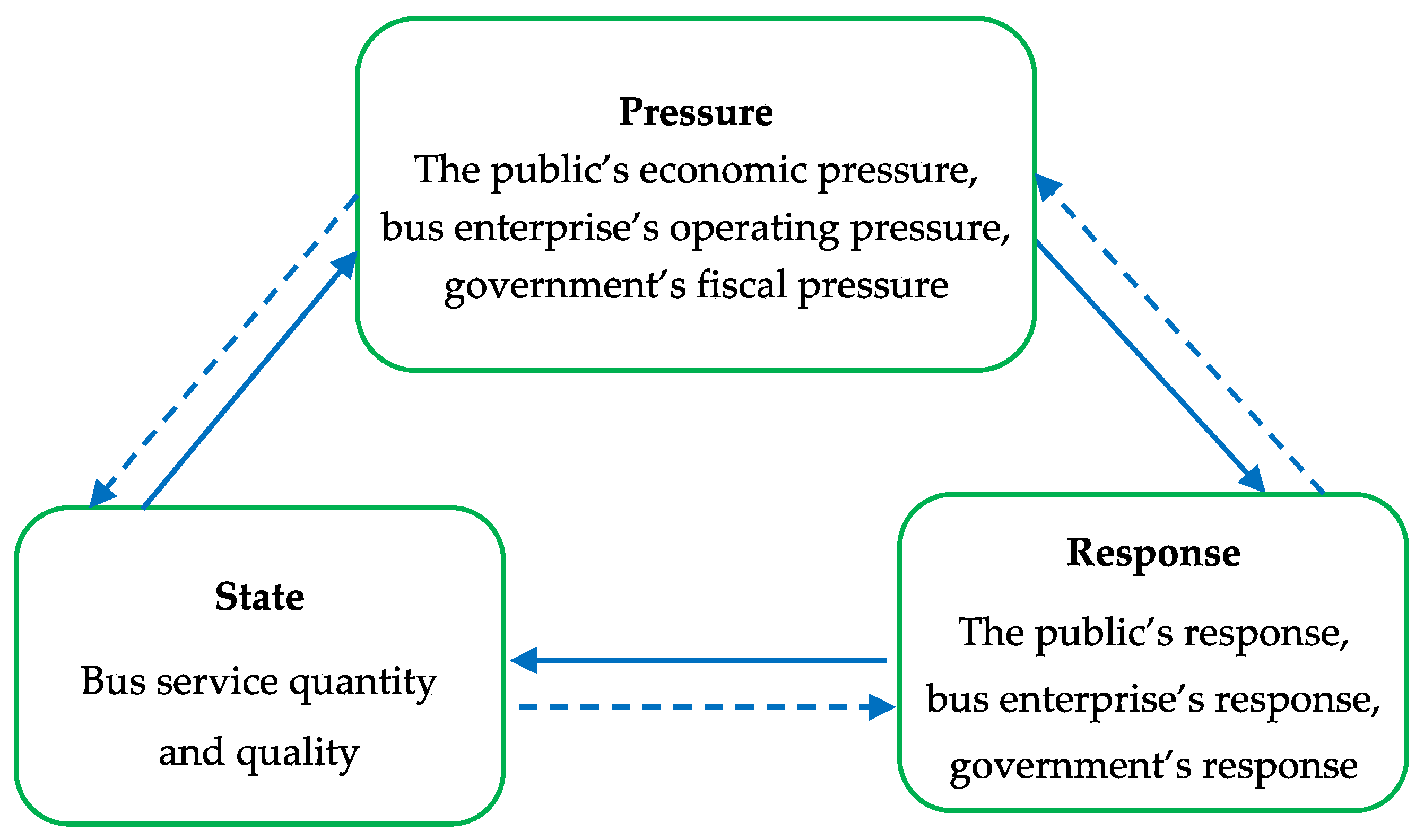
Video Upload Options
Sustainable development has reached a consensus in all fields of the world. Transport sustainability is the mainstream of sustainable development goals. As a key component of urban transportation systems, the role of public transport has been established as a critical element in promoting sustainable development due to its affordability, efficiency and convenience. From the description by the previous literature, public transport sustainability generally can be broadly and narrowly defined. In a broad sense, the development of public transport coordinates with the urban economy, society, and environmental resources. In a narrow sense, dynamic transit bus networks, smart technological support and effective fare policy are also related to the sustainable development of public transport.
1. Introduction
2. Transport Sustainability

3. Establishing the Sustainability Evaluation Index System
3.1. Application of PSR Model

3.2. Evaluation Indicator Selection
| Aspect | Indicator | Symbol | Positive Tendency |
|---|---|---|---|
| Pressure | Per capita bus costs as a percentage of disposable income (%) | C1 | − |
| Passenger revenue as a percentage of operating costs (%) | C2 | + | |
| Bus subsidy as a percentage of fiscal revenue (%) | C3 | − | |
| State | Bus service coverage (%) | C4 | + |
| Bus ownership ratio (vehicles/10,000 population) | C5 | + | |
| Departure frequency (vehicles/h) | C6 | + | |
| Average operating speed during morning and evening peak hours (km/h) | C7 | + | |
| Mean crowding during morning and evening peak hours (%) | C8 | − | |
| Response | Bus modal share in motorized travel (%) | C9 | + |
| Operating cost per vehicle—kilometer (CNY) | C10 | − | |
| Proportion of subsidy linked to performance (%) | C11 | + |
3.2.1. Pressure Indicators
3.2.2. State Indicators
3.2.3. Response Indicators
References
- Gwilliam, K. A review of issues in transit economics. Res. Transp. Econ. 2008, 23, 4–22.
- Fei, S. Parking versus public transport subsidies: Case study of Nanjing, China. Transp. Lett. 2016, 8, 90–97.
- Li, R.; Yang, X.; Shi, Q. Study of urban public transportation finance subsidy policy abroad. Urban Stud. 2002, 3, 62–65+70.
- Yao, D.; Xu, L.; Li, J. Does technical efficiency play a mediating role between bus facility scale and ridership attraction? Evidence from bus practices in China. Transp. Res. Policy Pract. 2020, 132, 77–96.
- McLeod, M.; Flannelly, K.; Flannelly, L.; Behnke, R. Multivariate time-series model of transit ridership based on historical, aggregate data: The past, present, and future of Honolulu. Transp. Res. Rec. 1991, 1297, 76–84.
- Borndörfer, R.; Karbstein, M.; Pfetsch, M.E. Models for fare planning in public transport. Discret. Appl. Math. 2012, 160, 2591–2605.
- Lee, M.T.; Yeh, C.F. Causal effects between bus revenue vehicle-kilometers and bus ridership. Transp. Res. Policy Pract. 2019, 130, 54–64.
- Chen, J.; Lin, C.; Liu, X. Microscopic Analysis on Current Situation of Public Transport Enterprises-Based on The Survey Data. Urban Public Transp. 2013, 6, 28–31.
- Kamel, I.; Shalaby, A.; Abdulhai, B. A modelling platform for optimizing time-dependent transit fares in large-scale multimodal networks. Transp. Policy 2020, 92, 38–54.
- Guo, Q.; Sun, Y.; Schonfeld, P.; Li, Z. Time-dependent transit fare optimization with elastic and spatially distributed demand. Transp. Res. Policy Pract. 2021, 148, 353–378.
- Asplund, D.; Pyddoke, R. Optimal fares and frequencies for bus services in a small city. Res. Transp. Econ. 2020, 80, 100796.
- Schipper, L. Sustainable urban transport in the 21st century: A new agenda. Transp. Res. Rec. 2002, 1792, 12–19.
- Thøgersen, J. Promoting public transport as a subscription service: Effects of a free month travel card. Transp. Policy 2009, 16, 335–343.
- Taylor, B.D.; Miller, D.; Iseki, H.; Fink, C. Nature and/or nurture? Analyzing the determinants of transit ridership across US urbanized areas. Transp. Res. Policy Pract. 2009, 43, 60–77.
- Chen, C.; Varley, D.; Chen, J. What affects transit ridership? A dynamic analysis involving multiple factors, lags and asymmetric behaviour. Urban Stud. 2011, 48, 1893–1908.
- Gkritza, K.; Karlaftis, M.G.; Mannering, F.L. Estimating multimodal transit ridership with a varying fare structure. Transp. Res. Policy Pract. 2011, 45, 148–160.
- Frondel, M.; Vance, C. Rarely enjoyed? A count data analysis of ridership in Germany’s public transport. Transp. Policy 2011, 18, 425–433.
- Wang, Z.; Li, X.; Chen, F. Impact evaluation of a mass transit fare change on demand and revenue utilizing smart card data. Transp. Res. Policy Pract. 2015, 77, 213–224.
- Liu, Y.; Wang, S.; Xie, B. Evaluating the effects of public transport fare policy change and built and non-built environment features on ridership: The case in South East Queensland, Australia. Transp. Policy 2019, 76, 78–89.
- Kholodov, Y.; Jenelius, E.; Cats, O.; van Oort, N.; Mouter, N.; Cebecauer, M.; Vermeulen, A. Public transport fare elasticities from smartcard data: Evidence from a natural experimen. Transp. Policy 2021, 105, 35–43.
- Curtin, J.F. Effects of fares on transit riding. Highw. Res. Rec. 1968, 213, 8–20.
- Cervero, R. Transit pricing research. Transportation 1990, 17, 117–139.
- Sharaby, N.; Shiftan, Y. The impact of fare integration on travel behavior and transit ridership. Transp. Policy 2012, 21, 63–70.
- Redman, L.; Friman, M.; Gärling, T.; Hartig, T. Quality attributes of public transport that attract car users: A research review. Transp. Policy 2013, 25, 119–127.
- Batarce, M.; Galilea, P. Cost and fare estimation for the bus transit system of Santiago. Transp. Policy 2018, 64, 92–101.
- Rye, T.; Carreno, M. Concessionary fares and bus operator reimbursement in Scotland and Wales: No better or no worse off? Transp. Policy 2008, 15, 242–250.
- Zhang, C.; Juan, Z.; Luo, Q.; Xiao, G. Performance evaluation of public transit systems using a combined evaluation method. Transp. Policy 2016, 45, 156–167.
- Ling, S.; Jia, N.; Ma, S.; Lan, Y.; Hu, W. An incentive mechanism design for bus subsidy based on the route service level. Transp. Res. Policy Pract. 2019, 119, 271–283.
- Pucher, J.; Kurth, S. Verkehrsverbund: The success of regional public transport in Germany, Austria and Switzerland. Transp. Policy 1995, 2, 279–291.
- Jin, Z.; Schmöcker, J.D.; Maadi, S. On the interaction between public transport demand, service quality and fare for social welfare optimisation. Res. Transp. Econ. 2019, 76, 100732.
- Wang, Q.; Li, S.; Li, R. Evaluating water resource sustainability in Beijing, China: Combining PSR model and matter-element extension method. J. Clean. Prod. 2019, 206, 171–179.
- Xie, X.; Huang, J. An Evaluation Analysis of Urban Entrepreneurship Environment Based on PSR Model: Case of Wuhan. China Soft Sci. 2017, 2017, 172–182.
- Peng, D.; Dong, T. Driving Force-State-Response Evaluation Method of Enterprise Green Innovation. Soft Sci. 2023, 37, 31–39. Available online: https://kns.cnki.net/kcms/detail/51.1268.G3.20220725.1840.013.html (accessed on 13 November 2023).
- Yang, Z.; Chen, X. Evaluation of urban rail transit sustainable development based on the PSR model. In Proceedings of the 16th COTA International Conference of Transportation Shanghai, 1941–1950, Shanghai, China, 6–9 July 2016.
- Kang, C.; Feng, C.; Liao, B.; Khan, A.H. Accounting for air pollution emissions and transport policy in the measurement of the efficiency and effectiveness of bus transits. Transp. Lett. 2019, 12, 349–361.
- Yang, C.; Yu, C.; Dong, W.; Yuan, Q. Substitutes or complements? Examining effects of urban rail transit on bus ridership using longitudinal city-level data. Transp. Res. Policy Pract. 2023, 174, 103728.
- Hall, J.D.; Palsson, C.; Price, J. Is Uber a substitute or complement for public transit? J. Urban Econ. 2018, 108, 36–50.
- Shi, K.; Shao, R.; Vos, J.D.; Cheng, L.; Witlox, F. The influence of ride-hailing on travel frequency and mode choice. Transp. Res. Transp. Environ. 2021, 101, 103125.
- Sakai, H.; Shoji, K. The effect of governmental subsidies and the contractual model on the publicly-owned bus sector in Japan. Res. Transp. Econ. 2010, 29, 60–71.
- Hensher, D.A. The Relationship between Bus Contract Costs, User Perceived Service Quality and Performance Assessment. Int. J. Sustain. Transp. 2014, 8, 5–27.
- Guirao, B.; García-Pastor, A.; López-Lambas, M.E. The importance of service quality attributes in public transportation: Narrowing the gap between scientific research and practitioners’ needs. Transp. Policy 2016, 49, 68–77.
- Ojo, K.T. Quality of public transport service: An integrative review and research agenda. Transp. Lett. 2019, 11, 104–116.
- Yao, D.; Xu, L.; Zhang, C.; Li, J. Revisiting the interactions between bus service quality, car ownership and mode use: A case study in Changzhou, China. Transp. Res. Policy Pract. 2021, 154, 329–344.
- Norouzian-Maleki, P.; Izadbakhsh, H.; Saberi, M.; Hussain, O.; Rezaee, J.M.; GhanbarTehrani, N. An integrated approach to system dynamics and data envelopment analysis for determining efficient policies and forecasting travel demand in an urban transport system. Transp. Lett. 2022, 14, 157–173.
- Thøgersen, J. Understanding repetitive travel mode choices in a stable context: A panel study approach. Transp. Res. Policy Pract. 2006, 40, 621–638.
- Bly, P.H.; Webster, F.V.; Pounds, S. Effects of subsidies on urban public transport. Transportation 1980, 9, 311–331.
- Lave, C. Measuring the Decline in Transit Productivity in the U.S. Transp. Plan. Technol. 1991, 15, 115–124.




